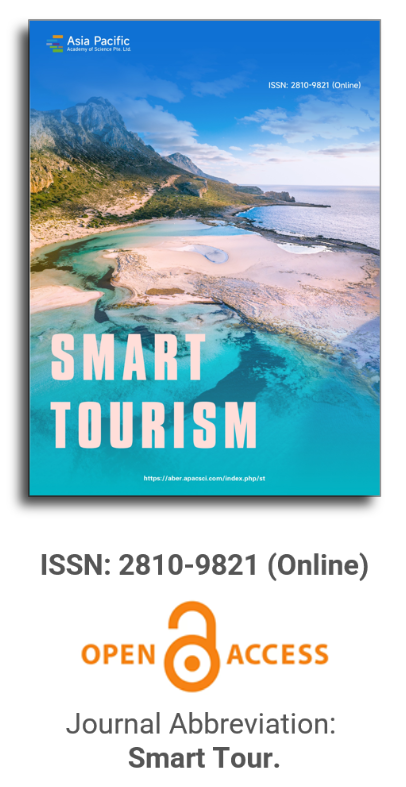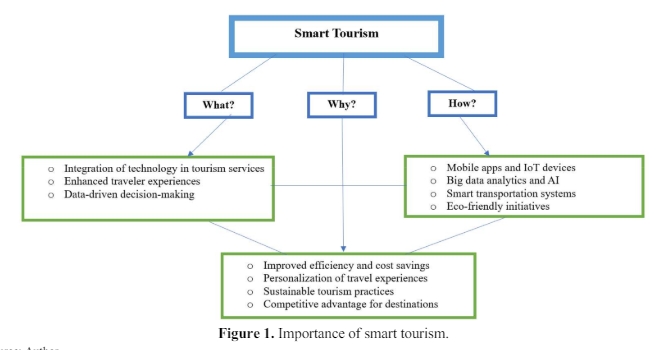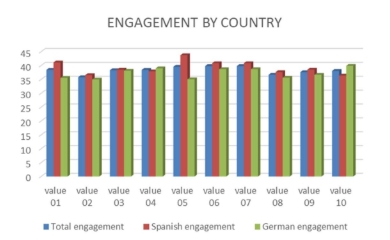
Publication Frequency
Semi-annual
Journal Articles
Search
Search scope
Volume Arrangement
Featured Articles

This commentary critically examines the integration of smart tourism technologies within the tourism and hospitality sectors, focusing on their role in enhancing tourist experiences and operational efficiencies. Through a multidisciplinary approach encompassing a literature review, case studies, and empirical data analysis, the analysis adopts a constructivist perspective to explore tourists’ subjective experiences with technology. It highlights significant personalization, efficiency, and sustainability advancements while acknowledging challenges related to digital infrastructure and privacy concerns. Advocating for a balanced and sustainable approach that respects environmental integrity and cultural heritage, the commentary concludes with recommendations for future research on the socio-economic impacts of smart tourism, ethical data usage, and the adaptation of technologies to diverse contexts. It calls for increased investment in digital infrastructure and stakeholder collaborative efforts to promote sustainable and inclusive tourism development.

The importance of the image of the tourist destination in the communication and marketing of a tourist destination is beyond doubt. For this reason, numerous studies address these issues. However, not so many do so from the perspective of the emotion the receiver feels, which is why this study deals with analyzing the emotion generated in the receiver through neuromarketing techniques and measuring the level of engagement felt. As a fundamental part of this study, we added the variable of cultural differences, both generically and specifically for gender and age. We are mainly guided by the theories of Life Cycle Theory and Generational Theory to analyze age differences. At the same time, gender differences are approached from the Gender Role Theory. The sample comprises one hundred individuals with apparent cultural differences, one sample of German origin and residence and the other of Spanish origin and residence, 50/50. We approached the study from the point of view of the emotion felt by the receiver of the message based on ten neuromarketing techniques (EGG) and ten images used by a famous tourist destination known in both countries. The results suggest that not only are there differences in the emotion felt after viewing images of a tourist destination, but that these differences are also explained by cultural background, gender, and age.
Farnese palace in Caprarola, Italy: Towards a people-centred brand image in a cultural tourism market
Article ID: 3145
Vol 6, Issue 1, 2025
DOI: https://doi.org/10.54517/st3145
Vol 6, Issue 1, 2025
Received: 9 December 2024; Accepted: 8 January 2025; Available online: 20 January 2025; Issue release: 30 June 2025
Download PDF
Abstract
The valorization of cultural identity-centered brand icons has become a requested action nowadays, promoting the marketing statement of local heritage sites that aren’t designated as UNESCO World Heritage. Thus, these sites might compete to enhance and safeguard cultural heritage and authentic cultural knowledge. Moreover, lessening the high negative impact of the customization approach on the conservation statement of the cultural asset, the research adopts a people-centered approach developing the interlinkages between cultural tourism marketing and conservative management to enhance the rapport between the community and the palace in a community-based cultural tourism manner. Therefore, this empirical study reviews the cultural significance of the Farnese Palace in Caprarola and its reflection on its marketing statement, developing its brand image. It applies an integrated method that combines quantitative and qualitative analysis. It mainly assesses 165 online questionnaires with the public audience. The findings of this study draw a proposal for generating a people-centered heritage branding image (logo and slogan) of the Farnese Palace in Caprarola that seeks to generate a lifelong learning memory for the community and a long-term brand image for the visitors’ mentality.
Keywords
heritage branding; historic palaces; people-centred approach; cultural value perception
References
- Di Pietro L, Guglielmetti MR, Mattia G, Renzi MF. Cultural heritage for economic growth: a case study on cultural consumer behaviour. In: Proceedings of the 15th QMOD conference on quality and service sciences; January 2012; Poznan, Poland.
- Kotler P, Keller KL. Marketing management, 12th ed. London: Pearson Prentice Hall; 2006.
- Adie BA. Franchising our heritage: The UNESCO World Heritage brand. Tourism Management Perspectives. 2017; 24: 48-53. doi: 10.1016/j.tmp.2017.07.002
- King LM, Halpenny EA. Communicating the World Heritage brand: visitor awareness of UNESCO’s World Heritage symbol and the implications for sites, stakeholders and sustainable management. Journal of Sustainable Tourism. 2014; 22(5): 768-786. doi: 10.1080/09669582.2013.864660
- Ryan J, Silvanto S. A Study of the Key Strategic Drivers of the Use of the World Heritage Site Designation as a Destination Brand. Journal of Travel & Tourism Marketing. 2014; 31(3): 327-343. doi: 10.1080/10548408.2013.876956
- Amer M, Ginzarly M, Renzi MF. Civita di Bagnoregio, Italy: towards a people-centred heritage branding approach. Journal of Heritage Tourism. 2023; 18(4): 483-503. doi: 10.1080/1743873x.2023.2188450
- Parenti B, Capasso S, Ercolano S, et al. Quantitative methods for the economic valuation of a cultural tourism destination: case study of the Pisa Charterhouse. Quality & Quantity. 2019; 54(5-6): 1577-1590. doi: 10.1007/s11135-019-00916-3
- Xu Z, Zhang H, Zhang C, et al. Exploring the Role of Emotion in the Relationship between Museum Image and Tourists’ Behavioral Intention: The Case of Three Museums in Xi’an. Sustainability. 2019; 11(3): 559. doi: 10.3390/su11030559
- Hosagrahar J, Soule J, Girard LF, Potts A. Cultural heritage, the UN sustainable development goals, and the new urban agenda. The Inclusive, Resilient, Safe and Sustainable City: Models, Approaches, Tools. 2016; 16(1). doi: 10.6092/2284-4732/4113
- Larsen PB. Modern conflict, emergencies and cultural heritage: Exploring the relevance of cultural rights. In: Proceedings of the international conference on the 20th anniversary of the 1999 second protocol of the 1954 Hague convention; 25 April 2019 - 26 April 2019; Geneva.
- Settimini E. Cultural landscapes: exploring local people’s understanding of cultural practices as “heritage.” Journal of Cultural Heritage Management and Sustainable Development. 2020; 11(2): 185-200. doi: 10.1108/jchmsd-03-2020-0042
- Wang CH. The necessity of taking a community approach in a historical cultural landscape conservation: a case of the Jianan Irrigation System in Taiwan. GeoJournal. 2018; 85(1): 107-126. doi: 10.1007/s10708-018-9950-8
- Kongprasert N, Virutamasen P. Tourist Perceptions to Cultural Identity: The Case of Thai Experience. Procedia - Social and Behavioral Sciences. 2015; 195: 167-174. doi: 10.1016/j.sbspro.2015.06.428
- UNESCO. Culture: urban future. global report on culture for sustainable urban development. Paris: UNESCO; 2016.
- Doğanli B. Ensuring branding in rural tourism via medical aromatic herbs and an empirical study. In: Economic and business issues in retrospect and prospect. London: IJOPEC Publication Limited; 2019.
- Schroeder J, Borgerson J, Wu Z. A brand culture approach to Chinese cultural heritage brands. Journal of Brand Management. 2015; 22(3): 261-279. doi: 10.1057/bm.2015.12
- Jian Y, Zhou Z, Zhou N. Brand cultural symbolism, brand authenticity, and consumer well-being: the moderating role of cultural involvement. Journal of Product & Brand Management. 2019; 28(4): 529-539. doi: 10.1108/jpbm-08-2018-1981
- Dastgerdi AS, Luca GD. Boosting city image for creation of a certain city brand. Geographica Pannonica; 2019.
- Matečić I, Perinić Lewis A. Island branding as a tool for reinforcing local island identities: the case of hvar. Acta turistica. 2018; 30(2): 155-184. doi: 10.22598/at/2018.30.2.155
- Montera R. Unforgettable brands: image heritage and consumer engagement in online communities. Sinergie Italian Journal of Management. 2018; (106): 63-79. doi: 10.7433/s106.2018.04
- Rindell A, Santos FP, de Lima AP. Two sides of a coin: Connecting corporate brand heritage to consumers’ corporate image heritage. Journal of Brand Management. 2015; 22(5): 467-484. doi: 10.1057/bm.2015.20
- Kotler NG, Kotler P, Kotler WI. Museum marketing and strategy: designing missions, building audiences, generating revenue and resources, 2nd ed. San Francisco: Jossey-Bass; 2008.
- Herget J, Petrů Z, Abrhám J. City branding and its economic impacts on tourism. Economics & Sociology. 2015; 8(1): 119-126. doi: 10.14254/2071-789x.2015/8-1/9
- Belbağ AG. A qualitative study on the branding potential of the Turkish city 'Bartın'. In: Proceedings of the 11th tourism outlook conference; 2-5 October 2018; Eskisehir, Turkey.
- Cheregi BF. Nation Branding in Transition Countries: A Multimodal Analysis of Romania and Moldova Tourism Campaigns. Journal of Entrepreneurship, Management and Innovation. 2018; 14(4): 81-106. doi: 10.7341/20181444
- Chaney D, Pulh M, Mencarelli R. When the arts inspire businesses: Museums as a heritage redefinition tool of brands. Journal of Business Research. 2018; 85: 452-458. doi: 10.1016/j.jbusres.2017.10.023
- Mérai D, Kulikov V. Alba Iulia citadel, Romania. EU-funded project OpenHeritage: organizing, promoting and enabling heritage reuse through inclusion, technology, access, governance and empowerment. Available online: https://openheritage.eu/wp-content/uploads/2018/11/16_OpenHeritage_Alba-Iulia_observatory-case.pdf (accessed on 28 September 2024).
- Rawls J. A Theory of Justice. Harvard University Press, Belknap Press; 1999.
- Felsing U. Dynamic identities in cultural and public contexts. Baden: Lars Müller Publishers; 2010.
- Guida FE. Dynamic identities for the cultural heritage. In: Proceedings of the 12th international conference "best practices in heritage conservation and management—from the world to Pompeii"; 2014.
- Chong KL. The side effects of mass tourism: the voices of Bali islanders. Asia Pacific Journal of Tourism Research. 2019; 25(2): 157-169. doi: 10.1080/10941665.2019.1683591
- Saufi A, O’Brien D, Wilkins H. Inhibitors to host community participation in sustainable tourism development in developing countries. Journal of Sustainable Tourism. 2013; 22(5): 801-820. doi: 10.1080/09669582.2013.861468
- Taylor C. Irreducibly social goods: philosophical arguments. Cambridge: Harvard University Press; 1995.
- Latour B. On Recalling Ant. The Sociological Review. 1999; 47(1_suppl): 15-25. doi: 10.1111/j.1467-954x.1999.tb03480.x
- Basile M. Local food, wine heritage and destination marketing: relaunching Valtellina Alpine destination. In: Economia della cultura. Società editrice il Mulino; 2018.
- Gravagnuolo A, Saleh R, Ost C, Girard LF. Towards an evaluation framework to assess cultural heritage adaptive reuse impacts in the perspective of the circular economy. Roma: INU Edizioni; 2018.
- Agrimi M, Borgna A, Cantone R, et al. The management of woodlands within the historic parks: the case study of forest stands in Villa Farnese at Caprarola (Viterbo, Italy). In: Proceedings of the 4th international congress on science and technology for the safeguard of cultural heritage in the mediterranean basin; 2010.
- Lippincott K. Two Astrological Ceilings Reconsidered: The Sala di Galatea in the Villa Farnesina and the Sala del Mappamondo at Caprarola. Journal of the Warburg and Courtauld Institutes. 1990; 53(1): 185-207. doi: 10.2307/751346
- Partridge L. The Room of Maps at Caprarola, 1573-75. The Art Bulletin. 1995; 77(3): 413. doi: 10.2307/3046119
- Partridge L. The Farnese Circular Courtyard at Caprarola: God, Geopolitics, Genealogy, and Gender. The Art Bulletin. 2001; 83(2): 259. doi: 10.2307/3177209
- Partridge LW. Vignola and the Villa Farnese at Caprarola—Part I. The Art Bulletin. 1970; 52(1): 81-87. doi: 10.1080/00043079.1970.10789976
- Partridge LW. The Sala d’Ercole in the Villa Farnese at Caprarola, Part I. The Art Bulletin. 1971; 53(4): 467-486. doi: 10.1080/00043079.1971.10790544
- Partridge LW. Divinity and Dynasty at Caprarola: Perfect History in the Room of Farnese Deeds. The Art Bulletin. 1978; 60(3): 494-530. doi: 10.1080/00043079.1978.10787591
- Recupero J. The Farnese palace at Caprarola. Rome: Arti Grafiche Parigi & Maggiorelli; 1990.
- Fitzgerald J, Bhiro R, Carbaugh N. CPR for the 4ps: Breathing new life into the marketing mix. European Journal of Business Research. 2014; 14(1): 69-86. doi: 10.18374/ejbr-14-1.6
- Keller KL. Building strong brands in a modern marketing communications environment. Journal of Marketing Communications. 2009; 15(2-3): 139-155. doi: 10.1080/13527260902757530
- Botschen G, Promberger K, Bernhart J. Brand-driven identity development of places. Journal of Place Management and Development. 2017; 10(2): 152-172. doi: 10.1108/jpmd-07-2016-0051
- Heding T, Knudtzen CF, Bjerre M. Brand Management. Routledge; 2020.
- Keller KL, Swaminathan V. Strategic brand management: building, measuring, and managing brand equity. London: Pearson; 2019.
- Kovaleva A, Epstein M, Parik I. National heritage branding: a case study of the Russian Museum of Ethnography. Journal of Heritage Tourism. 2017; 13(2): 128-142. doi: 10.1080/1743873x.2017.1343337
- Soboleva ES, Epstein MS. Museum branding: process and tools. In: Proceedings of museum in the world of culture: world of culture in the museum; 2015.
- Gustafsson C, Amer M. Forsvik, Sweden: Towards a People–Public–Private Partnership as a Circular Governance and Sustainable Culture Tourism Strategy. Sustainability. 2023; 15(5): 4687. doi: 10.3390/su15054687
- Doyle P. Value-based marketing: marketing strategies for corporate growth and shareholder value. John Wiley & Sons; 2008.
- Vollero A, Dalli D, Siano A. Brand negotiation and brand management. An actor-network theory perspective. Mercati & Competitività. 2016; (4): 23-41. doi: 10.3280/mc2016-004003
Supporting Agencies
Copyright (c) 2025 Mohamed Amer, Anna Kovaleva
License URL: https://creativecommons.org/licenses/by/4.0/

This site is licensed under a Creative Commons Attribution 4.0 International License (CC BY 4.0).
Editor-in-Chief

Prof. Hung-Che Wu
Nanfang College, Guangzhou
China
Indexing & Archiving
News & Announcements
2025-01-09
A Thank You Letter from Smart Tourism!
As we bid farewell to 2024, we take immense pride in reflecting on the 28 distinguished works that have been meticulously published online following a rigorous peer-review process. We extend our heartfelt gratitude for authors' invaluable contributions, reviewers' steadfast support, and EBM's insightful guidance throughout the year. Your dedication and expertise have been instrumental in propelling Smart Tourism towards its current success.
2024-07-05
Call for Reading: Volume 5 Issue 1 Available
We are pleased to announce the release of Volume 5 Issue 1 of Smart Tourism. We sincerely invite researchers to download and read articles in this issue. It is hopeful that the content will bring readers new perspectives and inspire the research in related field.
2024-01-15
New layout style in 2024
In 2024, Smart Tourism will adopt a new layout style. Please turn to the "Author Guidelines" for preparing your manuscripts.
Journal Center
Asia Pacific Academy of Science Pte. Ltd. (APACSCI) specializes in international journal publishing. APACSCI adopts the open access publishing model and provides an important communication bridge for academic groups whose interest fields include engineering, technology, medicine, computer, mathematics, agriculture and forestry, and environment.



.jpg)
.jpg)

.jpg)

